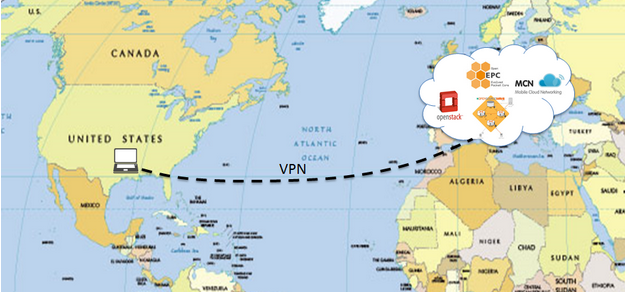As part of the on-going work in MobileCloud Networking the project will demonstrate outputs of the project at this year’s Globecomm industry-track demonstrations. Globecomm is being held this year in Austin, Texas.
MobileCloud Networking (MCN) approach and architecture will be demonstrated aiming to show new innovative revenue streams based on new service offerings and the optimisation of CAPEX/OPEX. MCN is based on a service-oriented architecture that delivering end-to-end, composed services using cloud computing and SDN technologies. This architecture is NFV compatible but goes beyond NFV to bring new improvements. The demonstration includes real implementations of telco equipment as software and cloud infrastructure, providing a relevant view on how the new virtualised environment will be implemented.
For taking the advantage of the technologies offered by cloud computing today’s communication networks has to be re-designed and adapted to the new paradigm both as developing a comprehensive service enablement platform as well as through the appropriate softwarization of network components. Within the Mobile Cloud Networking project this new paradigm has been developed, and early results are already available to be exploited to the community. In particular this demonstration aims at deploying a Mobile Core Network on a cloud infrastructure and show the automated, elastic and flexible mechanism that are offered by such technologies for typical networking services. This demonstration aims at showing how a mobile core network can be instantiated on demand on top of a standard cloud infrastructure, leveraging key technologies of OpenStack and OpenShift.
The scenario will be as following:
- A tenant (Enterprise End User (EEU), in MCN terminology) – may be an MVNO or an enterprise network – requests the instantiation of a mobile core network service instance via the dashboard of the MCN Service Manager – the the service front-end where tenants can come and request the automated creation of a service instance via API or user interface. In particular the deployment of such core network will be on top of a cloud hosted in Europe. At the end of the provisioning procedures, the mobile core network endpoints will be communicated to the EEU.
- The EEU will have the possibility to access the Web frontend of the Home Subscriber Server (HSS) and provision new subscribers. Those subscribers information will be used also for configuring the client device (in our case a laptop).
- The client device will send the attachment requests to the mobile core network and establish a connectivity service. Since at the moment of the demonstration the clients will be located in the USA, there will be a VPN connection to the eNodeB emulator through which the attachment request will be sent. At the end of the attachment procedure all the data traffic will be redirected to Europe. It will be possible to show that the public IPs assigned to the subscriber are part of the IP range of the European cloud testbed.
- The clients attached to the network will establish a call making use of the IP Multimedia Subsystem provided by the MVNO. During the call the MVNO administrator can open the Monitoring as a Service tool provided by the MCN platform and check the current situation of the services. For this two IMS clients will be installed on the demonstration device.
- At the end of the demonstration it will be possible to show that the MVNO can dispose the instantiated core network and release the resources which are not anymore necessary. After this operation the MVNO will receive a bill indicating the costs for running such virtualized core network.
It specifically includes:
- An end-to-end Service Orchestrator, managing dynamically the deployment of a set of virtual networks and of a virtual telecom platform. The service is delivered from the radiohead all the way through the core network to service delivery of IMS services. The orchestration framework is developed on an open source framework available under the Apache 2.0 license and is where the ICCLab actively develops and contributes.
- Interoperability is guaranteed throughout the stack through the adoption of telecommunication standards (3GPPP, TMForum) and cloud computing standards (OCCI).
- A basic monitoring system for providing momentary capacity and triggers for virtual network infrastructure adaptations. This will be part of the orchestrated composition.
- An accounting-billing system for providing cost and billing functions back to the tenant or the provisioned service instance. This will be part of the orchestrated composition.
- A set of virtualised network functions:
- A realistic implementation of a 3GPP IP Multimedia Subsystem (IMS) based on the open source OpenIMSCore
- A realistic implementation of a virtual 3GPP EPC based on the Fraunhofer FOKUS OpenEPC toolkit,
- An LTE emulation bases on the Fraunhofer FOKUS OpenEPC eNB implementation
- Demonstration of IMS call establishment across the provisioned on-demand virtualised network functions.
